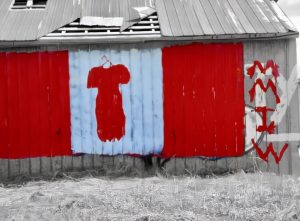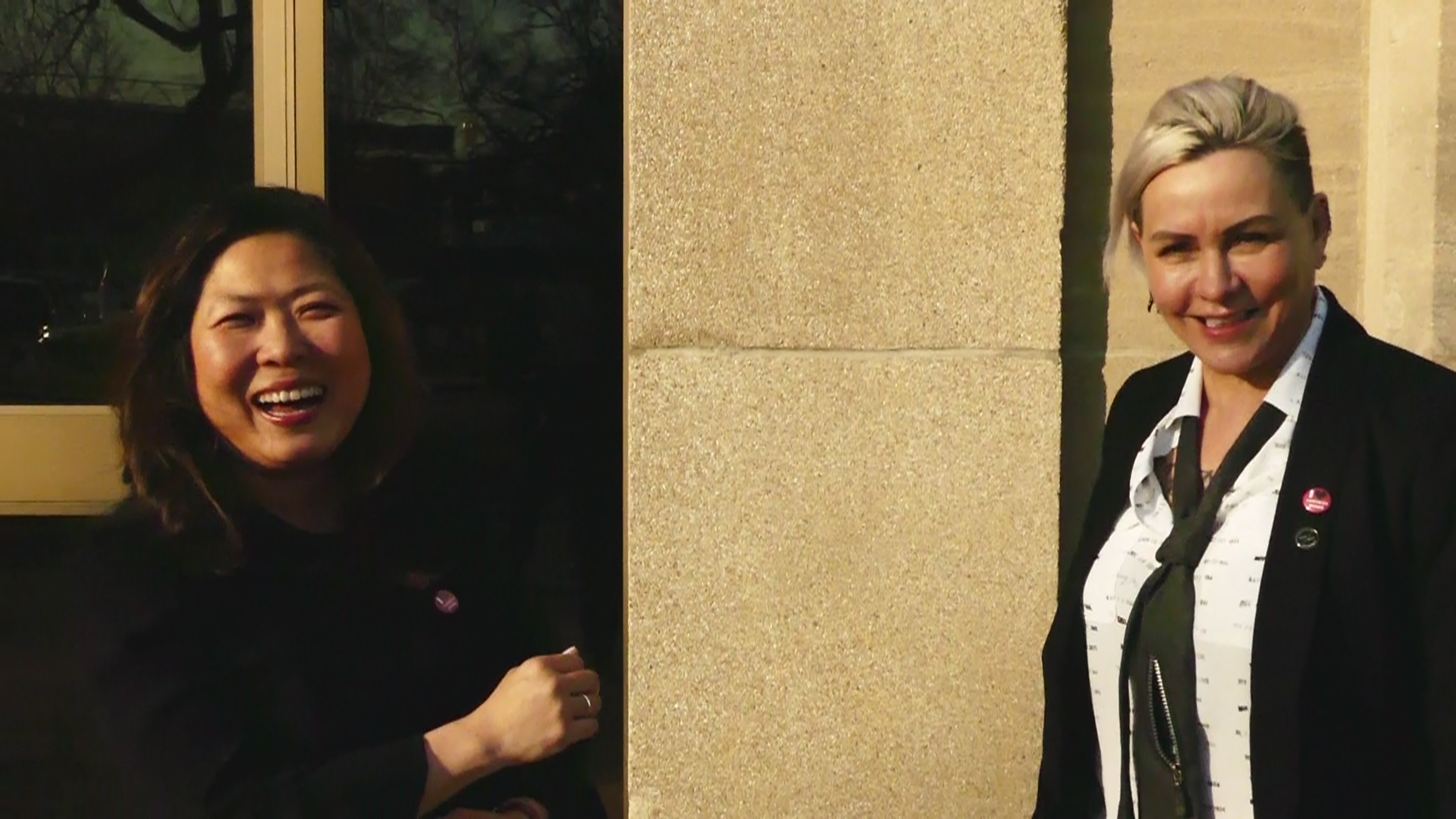 Art: “Patience” by Chief Lady Bird.
Art: “Patience” by Chief Lady Bird.
During the long drive to my new home in northwestern Ontario, I pass numerous Trading Posts that line the highway. I love Indigenous-made products and art but these places are often depressing, trading more in the fetishization and commercialization of Indigeneity for the amusement of colonial settlers.
The Trading Post I stopped into at Espanola featured an Indigenous section with leather products and some authentic traditional artwork. I picked out gorgeous moccasins but when I reached the checkout, I gagged at shelves lined with knock-offs—appropriated Indigeneity, Canada 150 promotional products, sweatshirts adorned with moose and Mounties, tacky souvenirs made who knows where.
Is a person meant to pair some Manitobah Mukluks with signature Hudson’s Bay Company striped mittens—one showing your appreciation of Indigenous culture, the other revealing just how deeply your thoughts are trapped in a colonial mindset? It’s a trendy look that makes me cringe.
I couldn’t buy the moccasins and couldn’t stop thinking about the colonial roots of Trading Posts—or Consumerism Posts as Chief Lady Bird of Mnjikaning First Nation (FN) calls them. I turned to her and Faith Redsky of Shoal Lake FN, two powerhouse Anishinabekwe artists, to help me understand how we can support the Indigenous Femxle* & Two-Spirited economy across Turtle Island, while avoiding the colonial commodification, appropriation and racism often on glaring display alongside Indigenous-made products.
Both have travelled the same winding highway and are equally perplexed by the continued existence of Trading Posts. As Chief Lady Bird asked, “What are we trading when we go in? We are exchanging money for goods. It’s not really trading; it’s just capitalism and consumerism, you know what I mean?”
So what does it mean to enter a real trading post? Let’s strap on our non-binary lenses and delve into these waters together, in an act of decolonizing our thought processes while learning new ways of being, knowing and supporting one another. Understanding Indigeneity outside of a monolith is an important step. That means respecting the opinions and teachings of each community, each individual.
Is a person meant to pair some Manitobah Mukluks with signature Hudson’s Bay Company striped mittens—one showing your appreciation of Indigenous culture, the other revealing just how deeply your thoughts are trapped in a colonial mindset? It’s a trendy look that makes me cringe.
I couldn’t buy the moccasins and couldn’t stop thinking about the colonial roots of Trading Posts—or Consumerism Posts as Chief Lady Bird of Mnjikaning First Nation (FN) calls them. I turned to her and Faith Redsky of Shoal Lake FN, two powerhouse Anishinabekwe artists, to help me understand how we can support the Indigenous Femxle* & Two-Spirited economy across Turtle Island, while avoiding the colonial commodification, appropriation and racism often on glaring display alongside Indigenous-made products.
Both have travelled the same winding highway and are equally perplexed by the continued existence of Trading Posts. As Chief Lady Bird asked, “What are we trading when we go in? We are exchanging money for goods. It’s not really trading; it’s just capitalism and consumerism, you know what I mean?”
So what does it mean to enter a real trading post? Let’s strap on our non-binary lenses and delve into these waters together, in an act of decolonizing our thought processes while learning new ways of being, knowing and supporting one another. Understanding Indigeneity outside of a monolith is an important step. That means respecting the opinions and teachings of each community, each individual.

Faith Redsky
Faith Redsky is a beader, designer, painter, and potter. She is inspired by traditional Ojibwe florals, contemporary and streetwear styles, and incorporates as many bright and beautiful colors into her work. One of her most recent pieces include the use of birch bark; earrings, pendants, bags etc.
How do we tell the difference between Indigenous-made and non-Indigenous-made products? Are Indigenous-made items merely a sum of their physical pieces?
Faith puts it this way: “I am not a sweatshop, I put my spirit and energy into my work.” Expecting Indigenous artists to create “on-demand” for others has negative impacts on mental, physical, emotional and spiritual wellbeing. She shared the need for buyers to understand that purchasing from Indigenous makers may cost more than appropriated knock-offs—and that is because you are also paying for their teachings, spirit and the time to create for the world. To ignore this would be to undervalue the sacredness of the items. Faith shared her teachings that beaded jewellery should be treated as sacred and not be worn when consuming alcoholic or other mind-altering substances or in settings where those substances are present, such as night clubs. “Something that was authentically made and handmade…coming from materials that were hunted ethically, tracked ethically, tanned in the community by people who hold this knowledge from their ancestors and their family, there is just something about it. It kind of goes beyond words when you come in contact with something that is made Indigenously.”
What are the biggest barriers facing Indigenous womxn* and Two-Spirited entrepreneurs attempting to navigate these patriarchal colonial spaces?
Both Chief Lady Bird and Faith identified a myriad of barriers, including the transactional platforms themselves. Faith shared that the lack of a centralized space to find local Indigenous makers—such as a mass website where you could search for moccasins, mukluks, pieces of regalia, etc—poses a challenge for smaller makers seeking to sell their wares. However, a centralized site is not without issues, as Chief Lady Bird eloquently expresses. These systems of purchasing defy the traditional ways of reciprocal being and take the spirit out of the transaction. It’s why she doesn’t have a website for her artwork, but utilizes social media as the tool for both engagement and sale.
As womxn* from historically Matriarchal communities, they identified the consumeristic patriarchal society we exist in as the largest barrier. It places expectations on womxn*, Indigenous womxn* in particular, to take advice from non-Indigenous folks, meet unrealistic mechanical deadlines and follow the colonial ways of being. Boundary setting, and staying true to oneself and teachings, is challenging but also the most important part of being an Indigenous entrepreneur.
It’s an act of resisting appropriation. As Chief Lady Bird described, “the whole colonial consumeristic capitalist mindset is like ‘let’s make a bunch of this for less money so more people get it and we make more money’ and that’s never been the Indigenous way of making and selling our goods … This mentality is just so ingrained and a lot of people are stuck in the system without realizing that they are stuck in it.” She went on to discuss the personal impacts of appropriation when she publicly stood up against Amanda PL, a non Indigenous artist working in the style of an acclaimed Indigenous painter. The backlash she endured — horrendously abused online, degraded in public shopping centres—detrimentally affected her wellbeing. She felt isolated and alone against the colonial world despite the immense strength she knew she carries with her as a proud Anishinabekwe.

Chief Lady Bird
Chief Lady Bird is a Chippewa and Potawatomi artist from Rama First Nation and Moosedeer Point First Nation, who is currently based in Rama. She graduated from OCAD University in 2015 with a BFA in Drawing and Painting and a minor in Indigenous Visual Culture.
How can non-Indigenous folks respectfully participate in supporting Indigenous femxle* and Two-Spirited entrepreneurs?
Chief Lady Bird shared that when it comes to jewelry or artwork “the overall general rule and consensus from the community is for non-Indigenous people to simply do their research, do their work to make sure that they are forwarding, supporting and uplifting and purchasing wares from actual Indigenous artists.” However, she expressed that “in terms of something like ribbon skirts I feel like that it is a little bit different because that’s something we would wear to ceremony and I feel that if someone non-Indigenous is buying it, they are not necessarily wearing in the intended way” – that is unless they are accepted by an Indigenous community where they are welcomed to participate in ceremonies and hold the teachings to do so, like her sister-in-law.
Faith added that we must understand that not every Indigenous artist creates in the same ways. Buyers need to respect the teachings of makers and their spiritual journey as making products is not simply about their source of income. You can do this by politely asking questions and not belittling artists, which happens frequently when a non-Indigenous purchaser is told that something cannot be made exactly as they wish it to be.
And now that we have deepened our understanding and decolonized the trading post, where can we find and support Indigenous femxle* and Two-Spirited entrepreneurs?
This Indigenous Women’s Holiday Market is a great place to start your search.
The Indigenous Media Network has compiled this list of local makers.
The InuitArt Quarterly provides a search site,
And this CBC article provides a number of helpful links and search tags.
Faith Redsky is a self taught artist from Shoal Lake 40 First Nations. Currently living in Thunder Bay, and attending Lakehead University for her degree in Bachelor of Education and Visual arts. She is a beader, designer, painter, and potter. She is inspired by traditional Ojibwe florals, contemporary and streetwear styles, and incorporates as many bright and beautiful colors into her work. One of her most recent pieces include the use of birch bark; earrings, pendants, bags etc.
Chief Lady Bird is a Chippewa and Potawatomi artist from Rama First Nation and Moosedeer Point First Nation, who is currently based in Rama. She graduated from OCAD University in 2015 with a BFA in Drawing and Painting and a minor in Indigenous Visual Culture. Chief Lady Bird’s art practice is continuously shapeshifting, and is always heavily influenced by her passion for empowering and uplifting Indigenous folks through the subversion of colonial narratives. She utilizes her social media platform(s) along with digital illustration, acrylic painting, mixed media portraits, and murals to centre contemporary truths and envision Indigenous Futurisms by portraying intersectional Indigenous experiences and asserting our presence on stolen land. Specifically, much of her work is based on the stories we tell through the reclamation of our bodies and sexuality, which often intersects with land sovereignty and language reclamation, and activates peripheral dialogues about tattooing practices, cultural appropriation, reconnection and various forms of love (self love,lateral love, ancestral love). She hopes that her images can be a catalyst for reimagining our relationship with the land, each other, and ourselves.
Chief Lady Bird has illustrated for notable organizations such as Chirp Magazine, Flare Magazine, the Art Gallery of Ontario, Scholastic and Vice News to name a few. In 2019 she provided the illustrations for the animated video “Land Acknowledgements And Why Are They Important” by Selena Mills and Local Love, which has been circulated widely throughout many educational institutions to guide educators toward a deeper understanding of Land Acknowledgements and their cultural significance. She also created the book cover design for Cherie Dimaline’s The Marrow Thieves UK release, and designed the #IndigenousPeoplesDay Turtle Island emoji for Twitter in 2018. In 2019, Chief Lady Bird illustrated the Scholastic children’s book Nibi’s Water Song authored by Sunshine Tenasco of Her Braids. This book follows the journey of a young Indigenous girl who fights for clean water for her community. As quoted by Quill and Quire: “Tenasco writes openly and honestly about the unequal treatment of Indigenous communities in Canada. Nibi’s song conveys the powerful message that clean water is a basic human right that should be afforded to everyone regardless of their ethnicity. The book successfully functions as a catalyst for an important conversation between parents and children.
Related Reading

CANADA DAY SPECIAL EDITION 2020
Decolonizing our hearts, how we commemorate our history and the story behind Stonewall

Remembering our Missing and Murdered Indigenous Women and Girls
June 3 was the first anniversary of the national inquiry into Missing and Murdered Indigenous Women and Girls (MMIWG). On Canada Day, we share Charlotte Snake’s photography as a way of keeping the conversation alive.

Decolonizing Our Hearts
A workshop on the topic provokes months of contemplation on how to see the world anew.




















